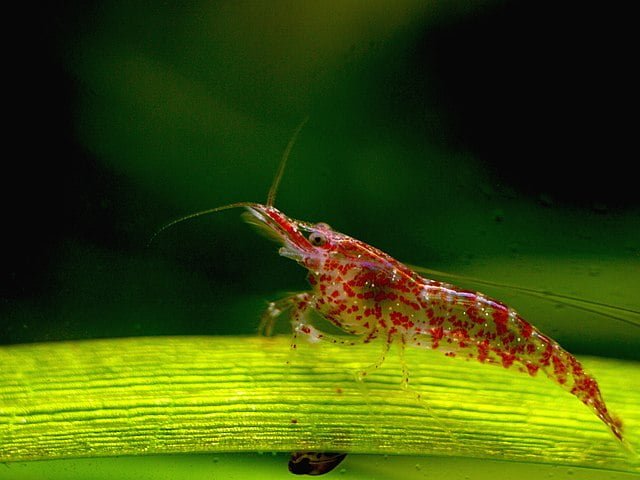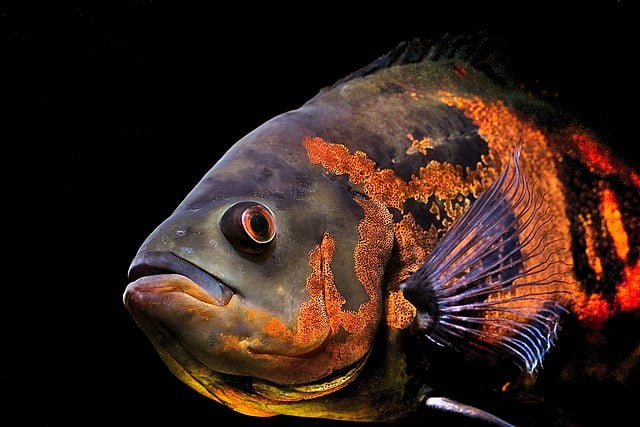Aquascaping, or planted aquariums, is an art form that harmoniously combines the art of nature with human creativity, transforming ordinary aquariums into captivating underwater masterpieces. It is a practice that not only enhances the aesthetic appeal of a living space but also cultivates a thriving ecosystem for aquatic life. Whether you’re an experienced aquarist or a curious beginner, delving into the world of aquascaping promises an enriching and rewarding experience.
Planted aquariums represent the ancient art of creating aquatic environments with modern trends, incorporating aquatic plants and ornamental fish into an aquarium (Kumari et al., 2021). Traditionally, aquariums and fish tanks aim to mimic natural environments or aquatic ecosystems inhabited by fish, crustaceans, mollusks, plants, or other aquatic organisms; however, aquascaping aims to create beautiful aquatic landscapes.
It is often perceived that creating a well-decorated planted tank requires a significant investment in CO2 injection equipment, lighting, filtration, substrates, or fertilizers. Nevertheless, technological advancements now allow for beautiful aquarium setups with a lower investment, depending on one’s creativity.
The goal of an aquarium is to provide an environment that mimics an aquatic ecosystem in your home, office, or any other setting. Additionally, planted aquariums also contribute to education and conservation efforts (Marchio, 2018). This article aims to provide an overview of aquascaping and its various styles.
- 1 What is aquascaping or planted aquarium?
- 2 Differences between aquariums and planted aquariums
- 3 Basic Principles of Aquascaping
- 4 Revealing the Benefits of Aquascaping
- 5 Types of Planted Aquariums
- 6 Styles of Planted Aquariums
- 7 Elements of Planted Aquarium
- 8 Technical Requirements for a Planted Aquarium
- 9 How to Design a Planted Aquarium?
- 10 Conclusion
- 11 References
- 12 Entradas relacionadas:
What is aquascaping or planted aquarium?
The term aquascaping has become increasingly popular among aquarium enthusiasts worldwide. Its popularity is attributed to Takashi Amano, who pioneered the decorative style in Japan (Sanaye and Tibile, 2009), focusing on recreating natural biotopes from specific regions (Buta et al., 2013).
Aquascaping, also known as planted aquariums, is defined as aquatic landscaping and includes techniques for creating, decorating, and organizing elements such as aquatic plants, rocks, driftwood, and other materials, where aquatic plants play a central role.
According to Kumari et al. (2021), aquascaping is akin to “gardening” in a fish tank (aquariums or fish tanks), with the primary objective being to create an artistic aquatic landscape. Although planted aquariums feature both plants and fish, it is also possible to create aquatic landscapes solely with plants (Sanaye and Tibile, 2009).
A planted aquarium is an ecosystem where living organisms and inert materials contribute not only to the aquarium’s beauty but also to the biological and chemical balance that supports plant and animal life within a closed aquatic environment (Akshitha and Girwani, 2020; Kumari et al., 2021).
Differences between aquariums and planted aquariums
“Aquascaping ” differ from “common aquariums” in their goal of creating an artistic aquatic landscape. The following table illustrates these differences in more detail:
Stay Always Informed
Join our communities to instantly receive the most important news, reports, and analysis from the aquaculture industry.
Table 01. Differences between aquariums and aquascaping.
| Difference | Aquarium (Conventional) | Aquascape |
|---|---|---|
| Appearance | Uses imitation ornamental plants for aquarium decoration | Enhances natural beauty with planted aquatic plants |
| Ecosystem | Focuses on water and fish equipment like filters, lights, heaters | Integrates water, plants, and animals for a balanced aquatic ecosystem |
| Level of difficulty | Primarily concerns fish maintenance | Requires skill in combining fish and aquatic plants |
| Tool usage | Simple tools for decoration | Utilizes high-tech tools for aesthetic arrangement |
| Light needs | Lights for aquarium beauty | Lights essential for both illumination and photosynthesis |
| Filter type | Any filter based on water volume | Preferably uses under gravel, canister, or biological filters |
| Fish selection | Freer choice of fish types and numbers | Selects fish compatible with aquatic plants |
| CO2 injection | Does not require CO2 injection | Requires CO2 injection, especially for heavily planted setups |
| Fish type | Can house any type of fish | Limited to calm fish that do not disturb plants |
| Number of fish | Based on aquarium size | Fewer fish to maintain balance with aquatic plants |
| Fertilizer application | No need for fertilizer | Requires fertilizer for plant nutrition |
Basic Principles of Aquascaping
Achieving the perfect balance between efficient use of scientific principles and creativity is attainable. Some basic principles that govern planted aquariums are:
i) Simplicity
ii) Variety
iii) Proportion
iv) Persistence
Revealing the Benefits of Aquascaping
Beyond its aesthetic appeal, aquatic landscaping offers a multitude of benefits that enrich both your living space and well-being.
- Enhancement of Home Decor: Aquascapes transform ordinary aquariums into captivating focal points, adding an artistic touch of nature to your home decor.
- Promotion of Tranquility and Stress Relief: The serene beauty of an aquatic landscape has a calming effect, promoting relaxation and stress reduction.
- Creation of a Prosperous Ecosystem for Aquatic Life: Aquascaping provides a conducive environment for aquatic plants and fish, fostering a harmonious and balanced ecosystem.
Types of Planted Aquariums
There are two types of planted aquariums based on their technology level:
- Low Tech Planted Aquarium: Uses plants with low light requirements. Requires less investment in equipment. Normal plant-specific lighting and minimal fertilizer are usually sufficient.
- High Tech Planted Aquarium: Uses plants with high light requirements. Requires higher investment in equipment. Needs abundant light, CO2 injection, and controlled fertilizer supplementation.
Styles of Planted Aquariums
Although there are no strict rules for creating underwater ecosystems (Buta et al., 2013), aquascaping styles are continually evolving.
There are several styles of planted aquariums such as Dutch, Japanese, Natural, Iwagumi, Jungle, Biotope, and Paludarium. According to Buta et al. (2013), the most common and significant styles are Dutch and Japanese, while Kumari et al. (2021) highlights that the Iwagumi style is one of the most popular planted aquariums.
Dutch Planted Aquarium
Plants take center stage. It utilizes a wide variety of aquatic plants arranged from left to right. More than 80% of the aquarium floor is covered with plants, and little or none of the substrate is visible (Harsha et al., 2019).
The Dutch aquarium follows an often symmetrical order, where different types of plants, with various leaf colors, sizes, and textures, are displayed in a manner akin to terrestrial plants in a flower garden.
Plants are placed in terraces of varying heights, but the Dutch style often omits rocks and driftwood.
The best plants for the Dutch planted aquarium include Lobelia cardinalis, Limnophila sessiliflora, L. aquatica, Ludwigia sp., Micranthemum micranthemoides, Alternanthera reineckii, Ammania gracilis, Rotala species, and Umbrosum sp.
As for fish, Congo tetras or angelfish are good choices for the Dutch style.

Natural Style Aquascaping
The natural aquascaping style was introduced in the 1990s by Takashi Amano from Japan. Takashi Amano’s Japanese planted aquarium technique is based on Japanese gardening techniques that aim to mimic natural landscapes with asymmetrical arrangements of relatively few species of plants, and carefully selected stones or driftwood.
The natural aquarium style is designed to maintain planted aquariums that remain simple and look natural.
Natural style planted aquariums are designed with plants that have small leaves, and freshwater fish or shrimp are usually selected as complements to the plants and for algae control.
Natural planted aquariums have three visual styles:
i) Concave shape
The position and height of the plants decrease towards a central low point, creating the impression of open space in the middle of the tank.
ii) Convex shape
This style is often referred to as an island because plants are smaller on both sides and taller in the middle, creating a visually appealing mountain-like landscape, which can be achieved with rocks.
iii) Triangle shape
This style creates well-balanced visuals; the height of the plants gradually decreases from tall on one side of the aquarium to low on the other side.

Japanese Planted Aquarium or Zen
For the Japanese, the art of planted aquariums must be structured, organized, and disciplined.
Many aspects of the Zen Buddhism religion are incorporated into the arrangement and placement of freshwater aquatic plants. In fact, the larger stones used in the aquarium should always be in odd numbers (1, 3, 5, etc.).
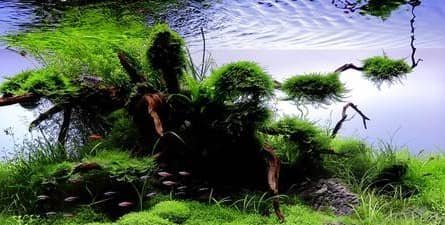
Biotope Aquascaping
Biotope aquascaping is designed to exactly replicate an aquatic habitat from a particular geographic location, and may not necessarily resemble a garden-like panorama.
Plants and fish may not be present, but if they are, they should reflect what naturally occurs in the habitat being represented.
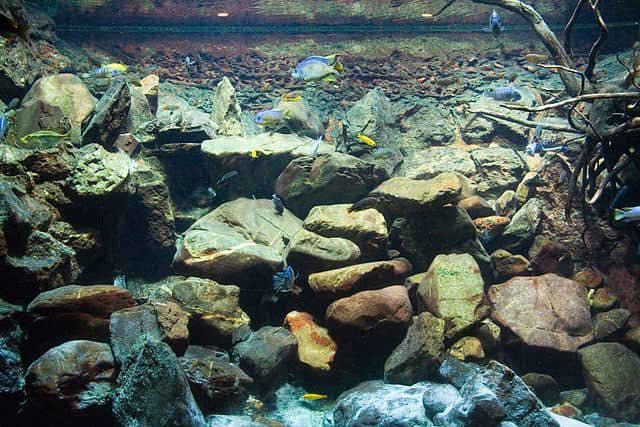
German Open Aquascaping / Paludariums
This style of aquascaping is known more as a combination of immersion and submerged setups.
The artists of these designs often start with aquatic plants that are planted submerged and allowed to grow until they emerge from the aquarium.
The goal of the biotope-style planted aquarium is to create a natural area that is more indicative of what you would find in a riparian zone, like along the edge of a waterway in the Amazon rainforest.

Planted Aquarium Iwagumi Style
The term Iwagumi in Japanese means “rock formation” and refers to a layout where stones play the primary role.
The Iwagumi planted aquarium includes grey stones arranged to form a tall, pointed structure on the right, and a similar but smaller structure on the left. The stone peaks and foreground are largely covered by a short layer of fine-textured green plants.
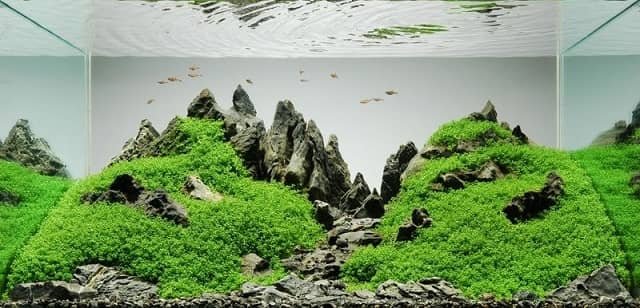
Planted Aquarium Jungle Style
Some enthusiasts distinguish the jungle style from Dutch and natural styles, although it incorporates some characteristics of both.
In the jungle planted aquarium, plants are allowed to grow naturally without trimming. Unlike the natural style, the jungle style does not follow clean lines or employ fine textures.
The jungle effect can be achieved using combinations of darker substrates, tall plants that grow to the surface, and floating plants that block light, creating a dappled lighting effect.

Marine Aquascaping
Marine aquascaping aims to mimic the appearance of a coral reef. Live rock forms the main structure of marine aquariums, populated with corals and other marine invertebrates, as well as coralline algae that serve the same aesthetic function as aquatic plants.
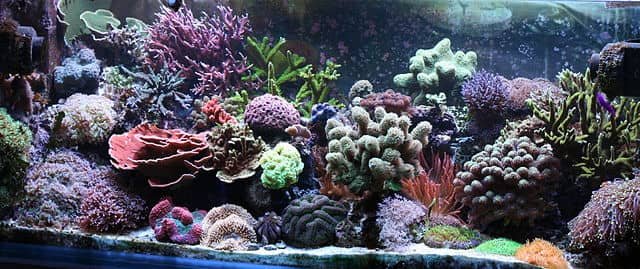
Elements of Planted Aquarium
To embark on your aquatic landscaping adventure, you’ll need to gather the essential elements that will form the foundation of your underwater masterpiece. Aquascaping encompasses several elements:
Aquarium
Choose an aquarium that suits the size and scope of your aquatic landscaping vision. Consider factors such as depth, width, and overall aesthetic appeal.
Aquatic Plants for Aquascaping
In different styles of planted aquariums, various sizes and shapes of aquatic plants are planted, considering the main elements of aquatic landscaping.
The importance of an aquarium containing aquarium plants is that these vegetables help control nitrogenous compounds and phosphorus in water, provide refuge and grazing for fish, serve as food in the case of some species.
Below I describe the aquatic plants used according to their height, based on studies by Sanaye and Tibile (2009) and Kumari et al. (2021):
i) Carpet Aquarium Plants (1 to 10 cm in height)
Creating plant carpets in an aquarium can simulate vast open fields, providing grazing, cover for shrimp.
Some plants that can be used are pygmy sword (Echinodorus tenellus), dwarf hairgrass (Eleocharis parvula), crystalwort (Riccia fluitans), Java moss (Vesicularia dubyana).
ii) Small Aquatic Plants (1-20 cm in height)
Suitable plants include dwarf Anubias (Anubias nana), Afzeli Anubias (Anubias afzelii), Green Wendtii crypt (Cryptocoryne wendtii), Brown Wendtii crypt (Cryptocoryne wendtii), Wavy crypt (Cryptocoryne undulata), Water barricade (Didiplis diandra), Needle Dart Rush (Eleocharis acicularis), Pearl grass (Hemianthus micranthemoides), Whorled Marsh Pennywort (Hydrocotyle verticillata), Baby Tears (Micranthemum umbrosum), Water cabbage (Samolus parviflorus).
iii) Medium Aquatic Plants (15-30 cm in height)
These aquatic plants are suitable for medium areas. Some examples of medium aquatic plants are Amazon Frogbit (Limnobium laevigatum), Giant Anubias (Anubias barteri), Coffee Leaf Anubias (Anubias barteri ‘coffeefolia’), Blyxa (Blyxa echinosperma, Blyxa japonica), African Water Fern (Bolbitis heudelotii), Cyperus (Cyperus helferi), Porto Alegre Sword (Echinodorus portoalegrensis), Eusteralis (Eusteralis stellata), Wide Leaf Ivy (Hemigraphis colorata), Brazilian Pennywort (Hydrocotyle leucocephala), Cardinal Flower (Lobelia cardinalis), Golden Moneywort (Lysimachia nummularia ‘Aurea’), Java Fern (Microsorum pteropus), Whorly Rotala (Rotala wallichii), Dwarf Sagittaria (Sagittaria subulata), Lizard’s Tail (Saururus cernuus).
iv) Tall Aquatic Plants (+31 cm in height, thin)
Ghost Echeveria (Echeveria lilacina), Bog Scarlet Hygro (Alternanthera sessilis var. Rubra), Pink Ammannia (Ammannia gracilis), “Fuzzy” Bacopa (Bacopa lanigera), Dwarf Bacopa (Bacopa monnieri), Green Cabomba (Cabomba caroliniana), Chinese Ivy (Cardamine lyrata), Elodea (Egeria densa), Stargrass (Heteranthera zosterifolia), Dwarf Hygrophila (Hygrophila polysperma), Sunset Hygro (Hygrophila polysperma ‘Rosanervig’), Dwarf Ambulia (Limnophila sessiliflora), Narrow Leaf Ludwigia (Ludwigia arcuata), Narrow Leaf Ludwigia (Ludwigia repens x arcuata), Creeping Red Ludwigia (Ludwigia repens), Red Ludwigia (Ludwigia mullertii), Inclined Red Ludwigia (Ludwigia inclinata), Oval Ludwigia (Ludwigia ovalis), Glandular Ludwigia (Ludwigia glandulosa perennis), Madagascar Lagarosiphon (Lagarosiphon madagascariensis), Mayaca (Mayaca fluviatilis), Brazilian Water Milfoil (Myriophyllum aquaticum), Western Milfoil (Myriophyllum hippuroides), Red Stem Milfoil (Myriophyllum mattogrossense), Southern Waternymph (Najas guadalupensis), Gayii (Potamogeton gayii), Mermaid Weed (Proserpinaca palustris), Dwarf Rotala (Rotala rotundifolia), Giant Red Rotala (Rotala macrandra), Tonina (Tonina sp.), Corkscrew Vall (Vallisneria spiralis var. tortissima).
v) Large Aquatic Plants (+31 cm in height, wide)
Madagascar Lace (Aponogeton madagascariensis), Orchid Lily (Barclaya longifolia), Water Sprite (Ceratopteris thalictroides), Wide Leaf Water Sprite (Ceratopteris cornuta), Eichhornia (Eichhornia azurea), Amazon Sword (Echinodorus amazonicus), Amazon Sword (Echinodorus martii), Ozelot Amazon Sword (Echinodorus ozelot), Giant Hygrophila (Hygrophila corymbosa), Water Wisteria (Hygrophila difformis), Red and Blue Water Lily (Nymphaea stellata), Red Water Lily (Nymphaea sp. “rubra”), Small Flower Water Lily (Nymphaea micrantha), Banana Plant (Nymphoides aquatica), Water Weed (Vallisneria spiralis).
vi) Floating Aquatic Plants
These plants grow and float on the water surface and provide shelter for ornamental fish.
Suitable plants for planted aquariums are duckweed (Lemna sp.), water lettuce (Pistia stratiotes), Aldrovanda (Aldrovanda vesiculosa), Azolla (Azolla filiculoides), floating moss (Salvinia natans), floating moss ears (Salvinia auriculata), Asian water moss (Salvinia cucullata).
Lighting
Proper lighting is essential for plant growth and overall aquarium health. Choose lighting systems that provide the intensity and spectrum suitable for the specific plants you want to grow.
Imagination and Creativity
Creativity is important for the design of planted aquariums. Think about the images of plants and accessories you have. Try combining them in various ways.
Backgrounds
There are different ways to choose a background like cork, wood, painted or self-adhesive.
If the fish tank is not kept in the middle of the room it is best to include a background, because it will be very unnatural to see the wall with all the hoses and cables.
Substrate
Substrate is an important requirement for a planted aquarium. In addition to providing support for plant growth, substrate promotes the production of bacteria that are important for nutrient circulation (nitrogen, phosphorus, etc).
Many different types of commercially available substrates can help plants grow. Some substrates that can be used are sand, clay, aquatic soil, gravel, soil, peat, and chopped coral. However, before choosing the substrate you need to know about its chemical properties because they could affect the quality of the water in the fish tank.
Design
Before placing the substrate, filtration system, plants, and fish, you should have a proper design. There are several types of styles, as described above, that you can employ.
Filtration
A robust filtration system is crucial for maintaining clean and healthy water conditions. Consider using a combination of mechanical, biological, and chemical filtration methods.
Landscape Materials
Rocks, driftwood, and other landscape elements provide structure, depth, and visual interest to the aquatic landscape. Choose hard materials that are safe for aquatic life and aesthetically pleasing.
Technical Requirements for a Planted Aquarium
Lighting
One of the most important accessories for a planted aquarium is lighting, as it has a significant influence on the growth and health of aquatic plants. Light should be considered the “heart” of the aquarium.
There is a wide variety of lighting systems, typically with a potential between 0.5 and 1 watt per liter. Cale (?) suggests that T8 and T5 fluorescent tubes are standard, but LED lights are becoming increasingly important. On average, a planted aquarium needs approximately 8 hours of light per day.
Hutabarat et al., (2023) developed an LED device that emits the light needed by plants; they also developed a system to control more than one LED device using an Android smartphone.
Filters
Filtration equipment is one of the most important parts of the aquarium when maintaining high fish densities, as it directly affects water quality by removing solid waste and converting ammonia from fish waste and unconsumed food into nitrates that can be utilized by plants.
Another important function of filters is water movement, ensuring that carbon dioxide (CO2) generated by aquatic organism respiration is diffused into the water to reach the plants.
Experts recommend always choosing a filter with at least 3 times the aquarium’s water volume per hour. For example, if your aquarium is 80 liters, the chosen filter should be capable of filtering 240 liters per hour.
There are three major groups of filters:
i) Internal filters: placed inside the aquarium
ii) Hang-on-back filters: hung on the back of the fish tank
iii) External filters: generally placed beneath the aquarium in a compartment of the supporting stand.
Carbon Dioxide (CO2)
CO2 systems are somewhat costly but essential for plant growth. However, whether to use CO2 in the aquarium depends on the desired results.
Incorporating CO2 into your planted aquarium has the following benefits:
i) Faster plant growth,
ii) Improved color and health of plants,
iii) Helps plants compete with algae,
iv) Allows cultivation of a wide selection of plants.
Liquid Fertilizers
Aquatic plants require a range of nutrients for their growth, which can be provided through fertilizers.
Depending on the light intensity and CO2 system in the aquarium, fertilizers should include macro and micronutrients, provided in appropriate doses for the aquatic environment.
According to Cale (?), when choosing a fertilizer, one should consider whether it is suitable for a CO2-injected aquarium or not. Aquariums without CO2 injection will use fertilizers without adding any macronutrients (nitrate, phosphate, and potassium).
How to Design a Planted Aquarium?
The design of your aquatic landscaping masterpiece is crucial for achieving balance and visual harmony. Consider the following principles when arranging the elements:
- Golden ratio: Employ the golden ratio, a mathematical proportion found in nature, to create a visually pleasing composition.
- Focal point: Establish a focal point, an element that draws attention, to guide the viewer’s gaze through the aquatic landscape.
- Depth and perspective: Use hardscapes and plants to create a sense of depth and perspective within the aquatic landscape.
Zhang et al., (2024) propose the design of planted aquariums based on Stable Diffusion Models (AG-SDM), prioritizing aesthetic principles and color coordination to provide guiding principles for real artists in Aquascaping creation; they conclude that the model excels in generating hyper-realistic underwater landscape images, closely resembling real flora, and achieves state-of-the-art performance in aquatic landscape design.
Moreover, when decorating a fish tank or aquarium, you should consider different Aquascaping techniques recommended by Aquascaping Love.
Conclusion
Planted aquariums are gaining increasing attention due to the beauty of aquatic landscapes created by enthusiasts. However, beyond the design criteria reported in this article, it is recommended that enthusiasts also acquire knowledge of aquatic ecology to enhance the management of their aquariums.
Ultimately, if you have already decided to venture into the exciting world of aquaristics, you can review some criteria for setting up your fish tanks.
References
Akshitha, S. and Girwani A. 2020. Aquascaping: An Incredible Art Under Water. Vigyan Varta 1(8): 59-62.
AquascapingLove.com. What is Aquascaping?
Buta E., Cantor M., Buta M., Husti A., Hort D., Buciuman A. 2013. Aquascaping: concept and development of underwater ecosystems. Vol. 56-2. Universitatea de Științe
Cale R. PLANTED AQUARIA: A Beginners Guide – Straight to the point. 10 p.
Harsha Haridas, K. Saravanan, J. Praveenraj, Ravindra Sontakke, Y Gladston, S.M. Ajina, Sreepriya Prakasan, R. Kiruba Sankar and S. Dam Roy. 2019. Training Manual on Freshwater Ornamental Fish Breeding and Aquascaping Techniques. ICAR::Central Island Agricultural Research Institute.
Hetami, A. A., Aransyah, M. F., & Andreana, A. G. (2023). Portrait of the aquascape industry in Indonesia: Business opportunities and challenges. AACL Bioflux, 16(1), 2023-679.
Hutabarat, D. P., Susanto, R., & Lukas, J. (2023, October). Controllable LED devices based on IoT application for aquascape environmental treatment. In AIP Conference Proceedings (Vol. 2510, No. 1). AIP Publishing.
ICA. Guía práctica del acuario plantado y el aquascaping. 100 p.
Kumari K., Nangunuri Varun Kumar, Thaneshwari and Chandresh Kumari. (2021). Art and science of aquascaping. 10. 240-245.
Marchio E. 2018. The Art of Aquarium Keeping Communicates Science and Conservation. Front. Commun., 20 April 2018 | https://doi.org/10.3389/fcomm.2018.00017
Sanaye S. and R. Tibile. 2009. The Fine Art of Aquascaping. Fishing Chimes, Vol. 29 No 7
Wikipedia. Paisajismo acuático.
Zhang, M., Yang, J., Xian, Y., Li, W., Gu, J., Meng, W., Zhang, J., & Zhang, X. (2024). AG-SDM: Aquascape generation based on stable diffusion model with low-rank adaptation. Computer Animation and Virtual Worlds, 35(3), e2252. https://doi.org/10.1002/cav.2252
Editor at the digital magazine AquaHoy. He holds a degree in Aquaculture Biology from the National University of Santa (UNS) and a Master’s degree in Science and Innovation Management from the Polytechnic University of Valencia, with postgraduate diplomas in Business Innovation and Innovation Management. He possesses extensive experience in the aquaculture and fisheries sector, having led the Fisheries Innovation Unit of the National Program for Innovation in Fisheries and Aquaculture (PNIPA). He has served as a senior consultant in technology watch, an innovation project formulator and advisor, and a lecturer at UNS. He is a member of the Peruvian College of Biologists and was recognized by the World Aquaculture Society (WAS) in 2016 for his contribution to aquaculture.

